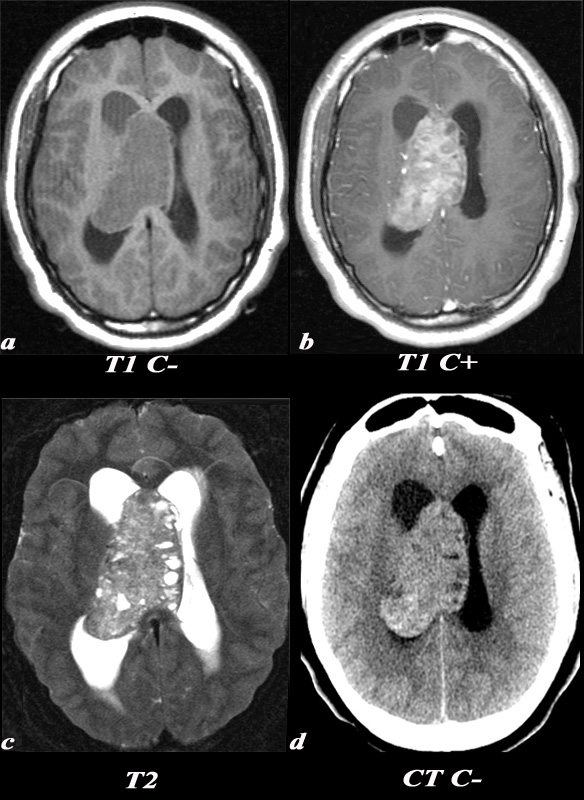Central Neurocytoma
The Common Vein Copyright 2010
Definition
A central neurocytoma is characterized as an intraventricular mass composed of uniform neoplastic cells with features of neuronal differentiation. It is a tumor that generally affects young adults.
The exact cell lineage from where they arise is uncertain. The histologic findings support a neuronal cell lineage however some evidence supports that they arise from progenitor cells also capable of glial differentiation. They are currently considered a neuroepithelial tumor
Pathologically, these cells appear as uniform round cells with round or oval nuclei, similar to oligodendrogliomas They also demonstrate expression of multiple neuronal markers on immunohistochemical studies. On electron microscopy neuronal cell elements such as microtubules and neurosecretory granules can be seen.
This intraventricular mass is most commonly located in the lateral ventricle, adjacent to the foramen of Monro and is attached to the septum pellucidum and leads to obstructive hydrocephalus.
Patients present with signs of increased intracranial pressure such as headache, nausea and vomiting.
Diagnosis is suggested by classic imaging findings but is ultimately made by pathologic evaluation.
Central neurocytomas are imaged by both CT and MRI. On CT, these are generally well circumscribed, lobulated masses which may be hyperdense and about half of the time, contain internal calcification. On MRI these lesions are heterogeneous on T1, isointense to hyperintense to gray matter on T2 with areas of both low T1 and T2 hypointensity which may be due to calcification or flow within vessels. After contrast administration, there is mild to moderate heterogeneous enhancement.
The first line of treatment is surgery and when complete it is curative. Radiation, chemotherapy or radiosurgery can be used after incomplete resection.

MRI and CT scan |
|
A 21 year old female was found to have papilledema on physical exam noted by her optometrist. MRI: T1 pre (T1 C- a) and post (T1 C+ b): Post contrast images demonstrate the heterogeneous enhancing nature of this mass. These images demonstrate centered in the right lateral ventricle with involvement of the septum pellucidum and partial extension into the left lateral ventricle. T2: T2 weighted images demonstrate internal areas of high signal consistent with cystic components. Also note the high T2 signal adjacent to the enlarged lateral ventricles which is a finding consistent with hydrocephalus, classically called transependymal flow of CSF. This unenhanced CT scan demonstrates also demonstrates the mass in the right lateral ventricle with similar features of heterogeneity and involvement of the septum pellucidum and partial extension into the left lateral ventricle. Notice the internal low density or cystic components and the higher density calcifications seen posteriorly. The lateral ventricles are enlarged consistent with resultant hydrocephalus. These findings are consistent with a diagnosis of central neurocytoma. Image Courtesy Elisa Flower MD and Asim Mian MD97634c01.8s |
|
H&E
NEUN Neuronal Nuclii Positive
Synaptophysin Central Neurocytoma |
|
This high power polymicrograph demonstrates a sea of small round blue cells. The “salt and pepper” appearance of the nuclei is a typical neuroendocine feature. The location of this tumor in combination with the histologic findings helps establish the diagnosis of central neurocytoma. Immunhistochemical staining is important for differentiating this tumor from oligodendroglioma which has a similar histologic appearance. Central neurocytomas are NeuN (neuronal nuclei) positive which is a neuronal marker. Immunohistochemistry staining with synaptophysin which identifies neuroendocrine or neural cells is also positive in central neurocytoma which is also quite helpful distinguishing it from oligodendroglioma. Images Courtesy of Cheryl Spencer, M.A. and Ivana Delalle, MD, PhD Department of Pathology Boston University School of Medicine 98487 (S07-412) |



